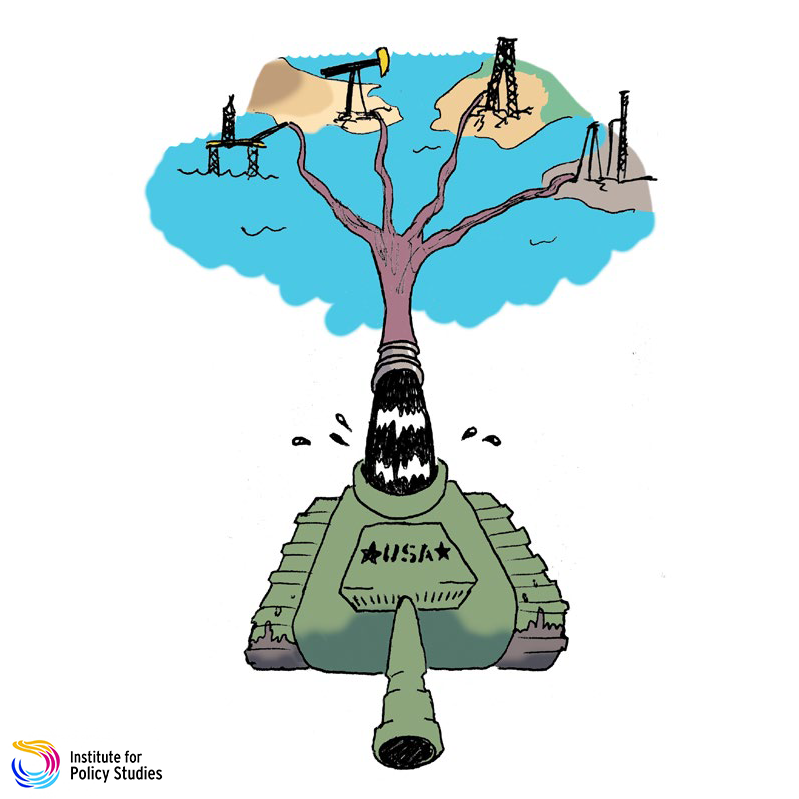The U.S. Military is a Major Polluter, but "Greening the Military" is a False Solution
By
Lorah Steichen
Posted:
|
Climate Change,
Military & Security

The carbon intensive U.S. military
The U.S. military is the world’s largest institutional consumer of oil and correspondingly, the single largest producer of greenhouse gases in the world. In any given year, the U.S. military pumps more greenhouse gases into the atmosphere than some industrialized countries. In 2017, the Pentagon’s total greenhouse gas emissions were greater than the greenhouse gas emissions of Sweden, Denmark, and Portugal. Indeed, the largest industrial military in the history of the world is also among the biggest polluters.
The U.S. operates more than 800 military installations around the world. Maintaining an expansive military sprawl requires significant investment in carbon-intensive infrastructure and gas-guzzling equipment. Fossil fuels are required to power bases, but also to fuel the non-stop movement of troops and supplies around the world that keep these installations running. Domestic and overseas military installations account for about 40% of the DoD’s greenhouse gas emissions.
Military operations, which include moving troops and carrying out missions, account for 70% of the U.S. military’s energy consumption. Just one of the military’s jets, the B-52 Stratofortress, consumes about as much fuel in an hour as the average car driver uses in seven years.
“Greening the military” is a false solution
The military’s significant carbon footprint has garnered attention from some progressive policymakers, and who have responded with plans to “Green the Military.” During her bid for the Democratic nomination for President of the United States, Elizabeth Warren released a plan to reduce the military’s carbon emissions by requiring the Pentagon to achieve net-zero emissions for all its non-combat bases and infrastructure by 2030 and commit billions of dollars to new Pentagon energy efficiency research.
While we should be critical of the U.S. military’s destructive environmental track record, “greening the military” is a false solution:
-
The reality is that solar energy, electric vehicles, or aspirations of “carbon neutrality” may promise fuel-efficiency but would not make the U.S. military any less violent or oppressive. Such proposals also tend to only address a fraction of the U.S. military’s fossil fuel consumption and emissions. For example, Senator Warren's plan excludes “operational” emissions sources, like the high-emitting aircraft used to transport troops and weaponry around the globe.
-
The U.S. military is deeply entwined with the fossil fuel industry. Jet fuel is the military’s most heavily-used fuel; each air mission produces hundreds of tons of CO2 pollution. Decarbonizing aviation is particularly challenging, as there is no comparable alternative to energy-dense jet-fuel, and at current trends, climate chaos far outpaces technological innovation in the electrification of air travel.
-
The United States has a well-known history of fighting wars for oil and, increasingly, deploys military power in response to climate threats and climate-related migration. Greening the military does nothing to change the purpose, strategies, or activities of the military, which are tied to upholding the extractive, fossil-fueled economy.
-
Not only is militarism a key feature of the extractive economy that drives climate change, the Pentagon also monopolizes the funding we need to seriously address the climate crisis. The military budget in 2020 was 272 times larger than the federal budget for energy efficiency and renewable energy.
Alternatives to “greening the military”
Instead of greenwashing the military, the following suggestions would drastically reduce greenhouse emissions, free up resources for green policies, and reduce U.S. reliance on militarism and war:
-
Close unneeded domestic and overseas bases. Closing as many as 60% or more of these bases would significantly reduce fossil fuel emissions, save as much as $90 billion that could be repurposed for green policies, and would make the world safer by raising barriers to armed conflict.
-
End all U.S. wars. The U.S. wars in Iraq and Afghanistan have emitted more than 1.2 billion metric tons of greenhouse gases into the atmosphere, resulting in an estimated 800,000 deaths and 21 million people displaced. Ending the wars would save lives, reduce emissions, and free up an additional $70 billion for green policies.
-
Cut weapons manufacturing. Needless weapons manufacturing creates more jets, ships, aircraft carriers, and more that increase emissions, needlessly increase nuclear power demands, ease the path to war, and in the case of nuclear weapons, present the other major existential threat to human existence besides climate change. Ending needless weapons manufacturing and eliminating nuclear weapons could save $100 billion for green policies.
Instead of investing in false solutions to "green" the U.S. war machine, we can redirect significant military resources including money, infrastructure, and people toward implementing real solutions to the climate crisis.